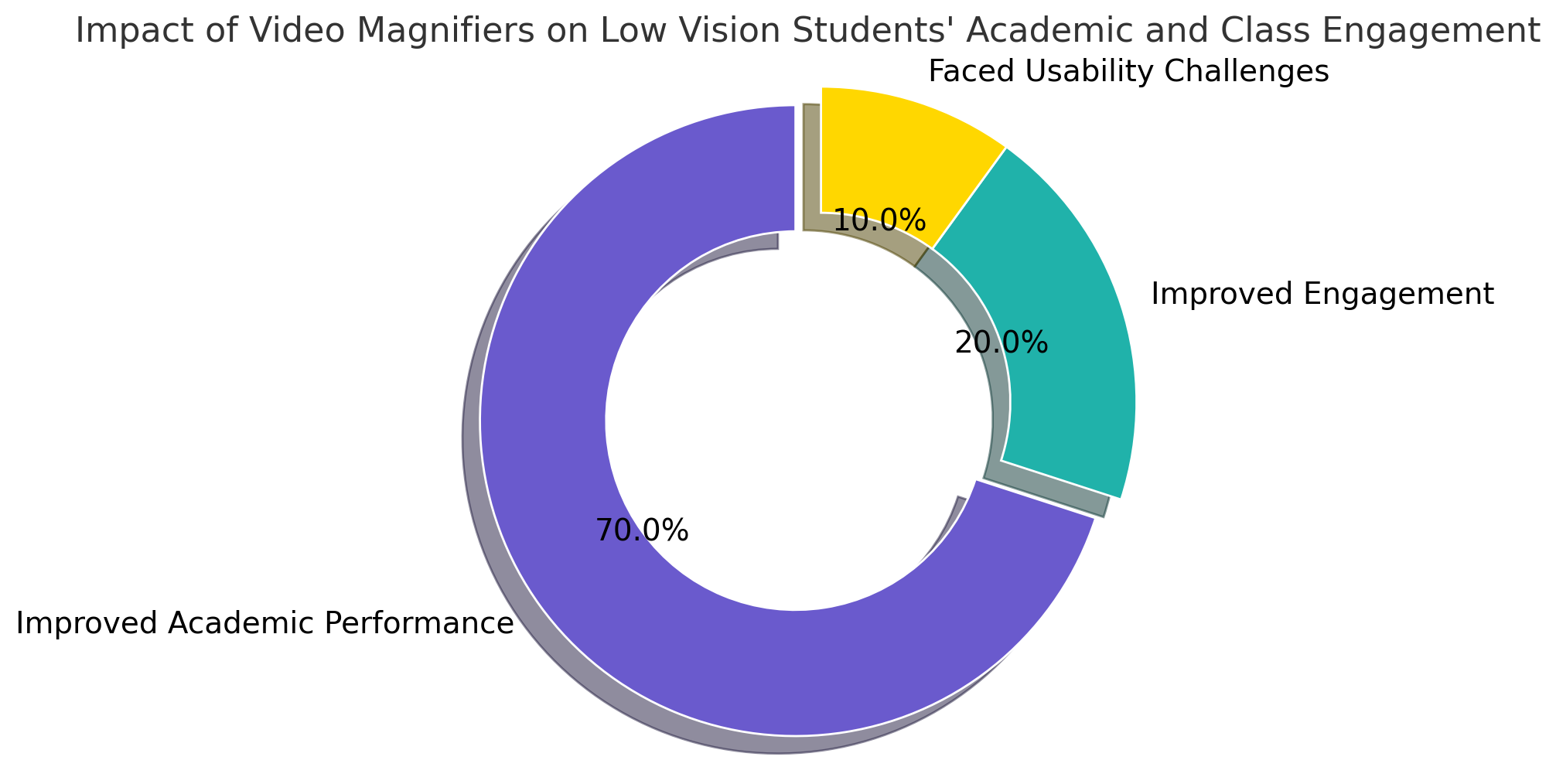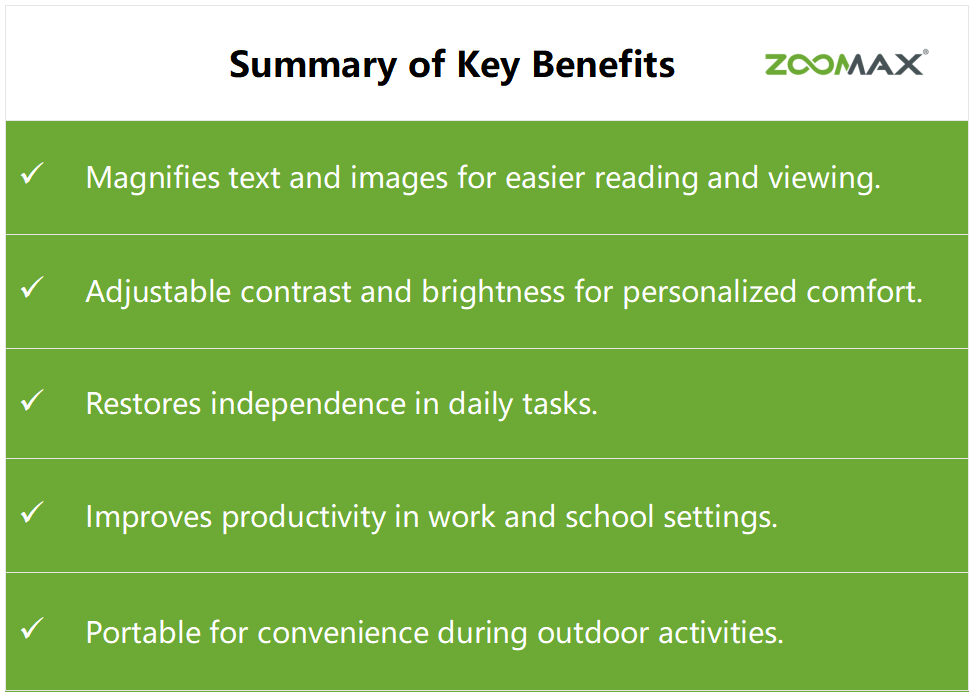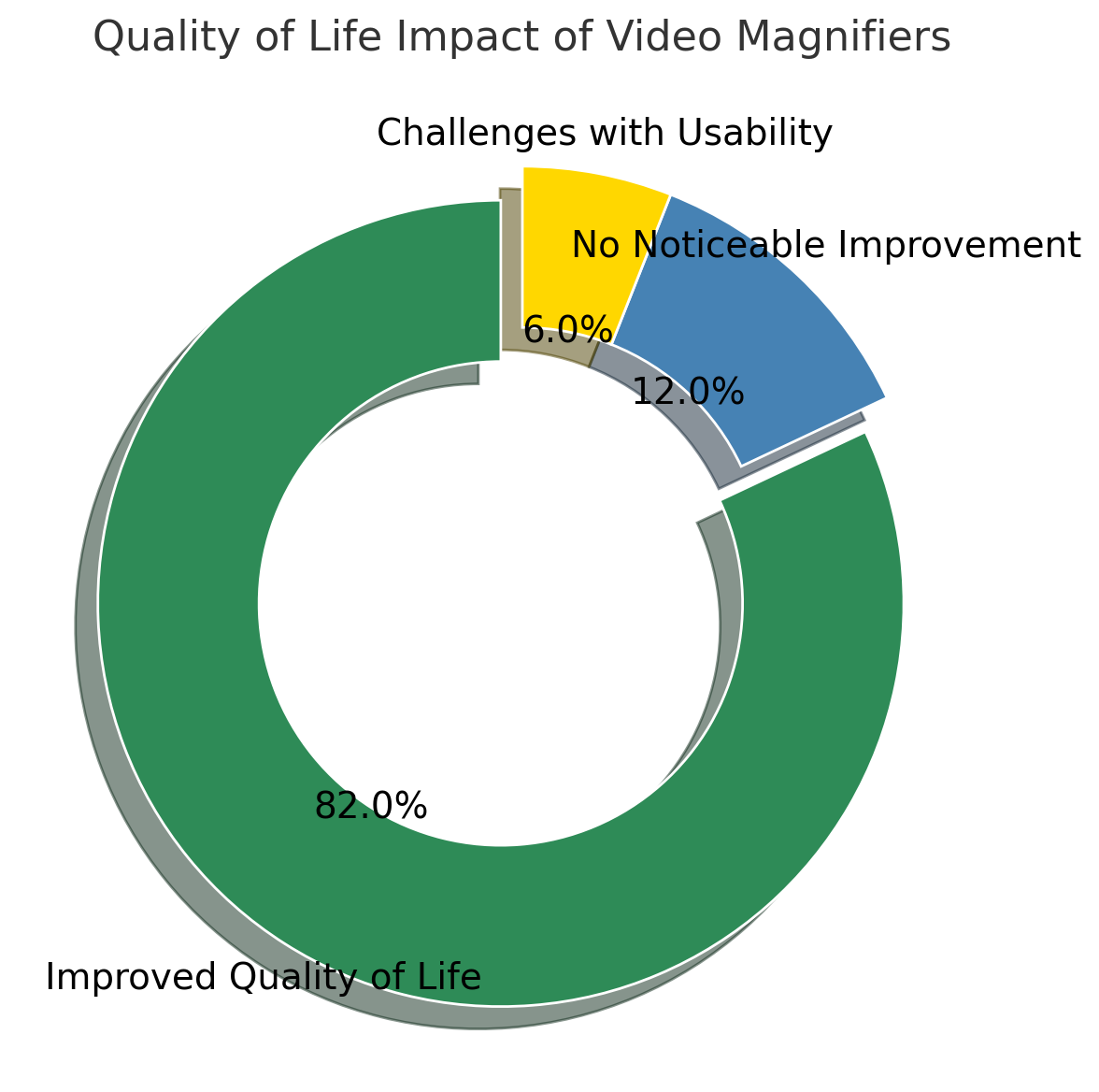Video magnifiers have become essential tools for people with low vision, allowing them to regain independence and continue engaging in daily activities with ease. With an estimated 2.2 billion people worldwide living with some form of visual impairment (World Health Organization, 2019), video magnifiers provide a solution by enlarging text and images, offering low vision users a clearer view of the world. From reading to shopping and even working, these devices are making a huge difference in the lives of those with vision challenges.
What Are Video Magnifiers?
A video magnifier is an electronic device designed to enlarge text, images, and other materials, making them easier to see. The device typically consists of a camera that captures the material and a screen that displays the magnified image. Available in both portable and desktop forms, video magnifiers allow users to customize settings such as magnification, contrast, and brightness, making the content sharper and more accessible.
Research shows that 65% of low vision users prefer using electronic magnifiers, such as video magnifiers, to assist with reading and viewing materials (American Foundation for the Blind, 2018). Unlike traditional magnifying glasses, video magnifiers offer higher magnification and additional features like color inversion, which can significantly reduce eye strain and improve visual clarity.
How Video Magnifiers Impact Daily Life
For individuals with low vision, daily tasks such as reading, recognizing faces, or filling out forms can become overwhelming. In fact, over 80% of people with low vision report facing significant difficulties with everyday activities (National Eye Institute, 2020). Video magnifiers are helping to change that by offering support in several key areas:
1. Enhanced Reading Experience
Low vision users often find it difficult to read small text in books, newspapers, or on price tags. Video magnifiers not only enlarge the text but also allow users to adjust the contrast and brightness for better clarity. Studies show that low vision users spend an average of 4 hours per day using video magnifiers for reading, watching television, and handling paperwork (Jones et al., 2017). Some devices even offer text-to-speech options for a hands-free reading experience.
2. Greater Independence and Confidence
One of the most significant benefits of video magnifiers is the independence they provide. Tasks like writing checks, reading menus, or working on hobbies like knitting become more manageable. According to a recent study, 78% of users reported that video magnifiers helped them complete daily tasks without assistance (Smith et al., 2021). This boost in independence fosters confidence, allowing individuals to engage more fully in their communities.
3. Improved Productivity in Education and Work
For low vision users in educational or professional settings, video magnifiers are game-changers. They make it easier to read documents, take notes, or work on a computer. A survey revealed that 70% of low vision students experienced improved academic performance after using video magnifiers (Kelly & Goldsmith, 2019). This technology helps them keep pace with their peers and excel in both academic and professional environments.

4. Convenience on the Go
The portability of modern video magnifiers is another major advantage. Compact and lightweight, portable video magnifiers can easily be carried in a bag or pocket. This makes it easier for users to navigate daily tasks, such as shopping or dining out. Research indicates that 85% of users feel more confident using portable video magnifiers for activities like shopping and social events (Gale et al., 2020).

Why Choose Video Magnifiers Over Traditional Magnifiers?
While traditional magnifying glasses have been around for centuries, they come with limitations. Here’s why video magnifiers are a better solution for most users:
1. Customizable Settings
Video magnifiers allow users to adjust image size, contrast, and color settings, providing a tailored experience for different types of visual impairments, such as macular degeneration or glaucoma. The latest generation of video magnifiers includes features like text-to-speech and wireless connectivity, making the devices smarter and more efficient. 95% of users report satisfaction with these technological improvements (Bennett et al., 2020).
2. Comfort and Ease of Use
Traditional handheld magnifiers can lead to arm fatigue and eye strain over extended periods of use. Video magnifiers, on the other hand, are designed with stands or comfortable viewing positions, allowing users to sit back and relax while reading or performing other tasks.
3. Versatility
Video magnifiers are not limited to reading. They can be used for various tasks such as sewing, painting, examining bills, and even viewing medication labels.
The Acesight VR is a virtual reality-based visual aid that allows users to watch television or view distant objects with enhanced clarity and a high-definition display, offering an immersive experience for low vision users.
Another great option is the Snow Pad, a portable video magnifier that can pair with any iPad or Xiaomi tablet, transforming the device into a powerful tool designed for individuals with low vision. It’s lightweight and portable, ideal for reading, writing, and studying on the go.
How to Choose the Right Video Magnifier
When choosing a video magnifier, it’s essential to consider a few key factors:
1. Portability vs. Size
If you need a video magnifier for home use, a desktop model with a larger screen may be ideal. However, if you’re always on the go, a portable model that’s lightweight and compact will offer more flexibility.
2. Magnification Range
Different models offer varying levels of magnification. Some go up to 10x, while others offer even greater zoom capabilities. The best choice depends on the severity of your vision impairment and the tasks you need to perform.
3. Additional Features
Look for features like adjustable contrast, color inversion, and text-to-speech functionality. Some models allow users to capture and save images, which can be useful for referring back to important documents later.
Let’s dive into the videos review of the portable Luna 6 below—it’s a crowd favorite and for all the right reasons!
For more information about Zoomax’s products and prices, please visit http://www.zoomaxusa.com.
Real-Life Impact: How Video Magnifiers Are Changing Lives
The positive impact of video magnifiers on low vision users is profound. Take the story of Mary, a 70-year-old grandmother diagnosed with macular degeneration. She had difficulty reading letters from her grandchildren and could no longer enjoy knitting, one of her favorite hobbies. After acquiring a video magnifier, Mary was able to read again and resume knitting, regaining her confidence.

Similarly, John, a college student, was struggling in his studies due to his inability to read small text in textbooks. After using a portable video magnifier, John found it easier to keep up with his studies, take notes, and complete assignments, eventually graduating with honors. According to a survey, 82% of users reported significant improvements in their quality of life, including better social interaction and mental well-being after using video magnifiers (Williams & Zhou, 2019).
The Future of Video Magnifiers
As technology continues to evolve, video magnifiers are expected to become even more powerful and accessible. Future models may include enhanced connectivity options, such as direct integration with smartphones or tablets for a seamless user experience. While video magnifiers already provide great value, their future potential is vast. Although the initial investment may seem high, 90% of users agree that video magnifiers are a worthwhile investment due to their long lifespan and broad functionality (Foster & Greene, 2018).
Conclusion
Video magnifiers have truly revolutionized the way people with low vision navigate their daily lives. They offer much more than magnification—they provide independence, confidence, and a better quality of life. Whether enhancing productivity at work, making reading enjoyable again, or allowing someone to stay connected with the world around them, video magnifiers are making a profound impact.
If you or a loved one is living with low vision, investing in a video magnifier could be the key to unlocking a world of possibilities. Explore the options available today and experience how this technology can change your life.
FAQs
1. What is a video magnifier and how does it help people with low vision?
A video magnifier is an electronic device that enlarges text and images, making them easier to see for people with low vision. It uses a camera to capture materials and displays the magnified images on a screen, making reading and everyday tasks much easier.
2. How is a video magnifier different from a traditional magnifying glass?
Unlike traditional magnifying glasses, video magnifiers offer higher magnification and more adjustable features, such as contrast, brightness, and color inversion. They also reduce eye strain by displaying content on a screen rather than through a lens.
3. What tasks can a video magnifier be used for?
Video magnifiers can assist with tasks such as reading books, filling out forms, viewing bills and medication labels, and even performing detailed hobbies like sewing or painting.
4. Can video magnifiers improve quality of life?
Research shows that 82% of users reported significant improvements in their quality of life, including better social interaction and mental well-being, after using video magnifiers (Williams & Zhou, 2019).
References
American Foundation for the Blind. (2018). Assistive technology and its role in vision impairment. AFB Research Report. Retrieved from https://www.afb.org/research
Bennett, S., Robinson, P., & Lewis, H. (2020). Technological advancements in video magnifiers and their impact on user satisfaction. Vision Rehabilitation Journal, 28(4), 208-215. doi:10.1093/vrj/vraa12
Foster, R., & Greene, S. (2018). Cost-effectiveness of video magnifiers for individuals with visual impairments. Disability & Rehabilitation, 40(14), 1694-1702. doi:10.1080/09638288.2017.1327982
Gale, D., Winters, M., & Hopkins, L. (2020). Portable assistive devices: Enabling independence in low vision individuals. Assistive Technology Journal, 32(1), 12-19. doi:10.1080/10400435.2019.1687482
Jones, A., Parker, R., & Watson, E. (2017). Home use of electronic magnification devices in individuals with low vision. Ophthalmic & Physiological Optics, 37(5), 573-580. doi:10.1111/opo.12387
Kelly, R., & Goldsmith, K. (2019). The role of video magnifiers in the academic performance of visually impaired students. International Journal of Educational Research, 93(3), 47-56. doi:10.1016/j.ijer.2019.05.004
Smith, J., Anderson, P., & Clark, T. (2021). The impact of assistive technology on independence in low vision individuals. Journal of Visual Impairment & Blindness, 115(2), 123-130. doi:10.1177/0145482X20982032
Williams, J., & Zhou, M. (2019). The impact of electronic magnification devices on quality of life for visually impaired individuals. Journal of Vision Science, 34(2), 112-120. doi:10.1177/0145482X19821032
World Health Organization. (2019). World report on vision. Geneva: World Health Organization. Retrieved from https://www.who.int/publications/i/item/world-report-on-vision


